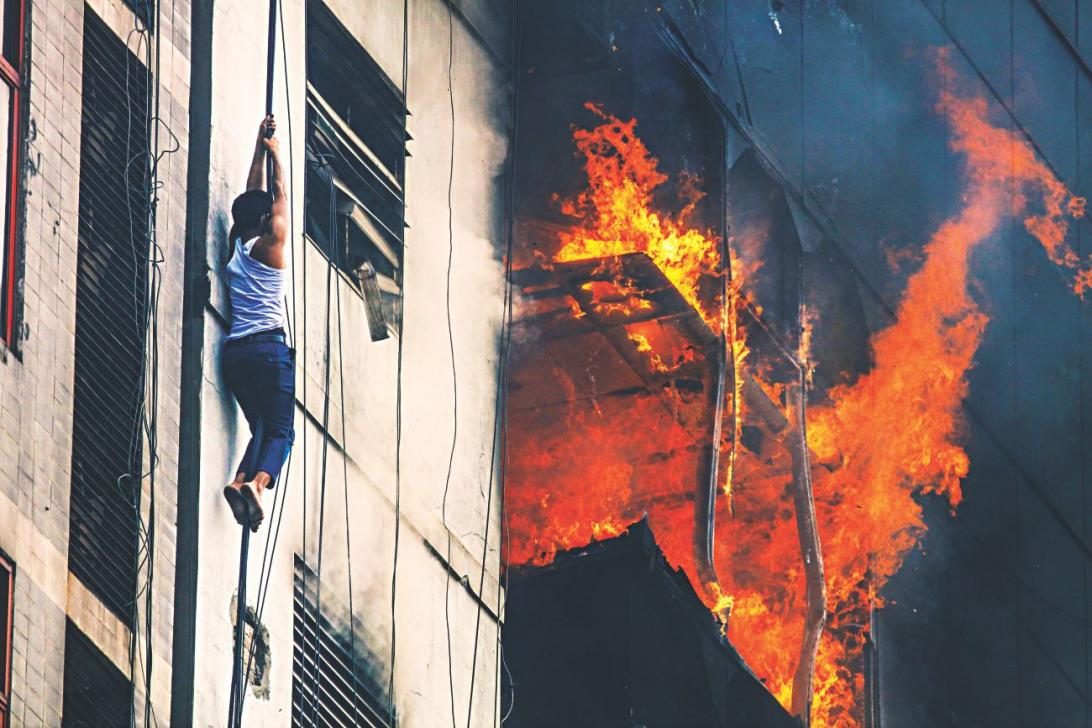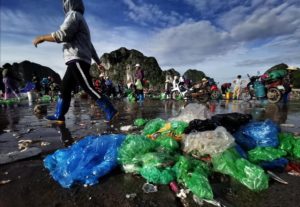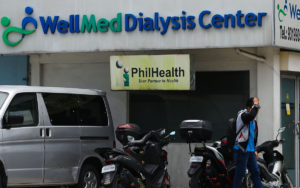Fires in commercial establishments do more damage than setting buildings ablaze.
Lives are lost, businesses disrupted and wounds take years to heal.
In Bangladesh, a survey by the Fire Service and Civil Defence headquarters, in 2017, showed that only 129 of 3,786 establishments in Dhaka, the country’s capital city, were not classified as “Risky” or “Extremely Risky”.
The results signal the high risk of accidents taking place.
On Mar 28, 2019, a massive fire engulfed the FR Tower in Dhaka’s commercial Banani area, killing 26 people and leaving around 100 people injured.
Barely a month ago, at least 70 people were killed after a fire broke out in an apartment building that was reportedly also used as a chemicals warehouse and spread to nearby buildings.
Fire accidents are not uncommon in densely populated Bangladesh owing to lax safety regulations and poor building conditions.
Officials say the problem is that the laws requiring buildings to have safety measures was enforced only in 2006.
There is a treasure trove of risk assessments conducted by urban planners over the years all nailing down the same conclusion — the city needs to be protected.
“In 2017 we surveyed over 3,500 schools, colleges, universities, hotels banks, hospitals, media houses and shopping markets within Dhaka city to assess their vulnerability to fire, and what we found was pretty frightening,” said Major AKM Shakil Newaz, the director of operations at the Bangladesh Fire Service and Civil Defence headquarters.
“None of the buildings built before 2006 have the things necessary for fire protection, because the Bangladesh National Building Code (BNBC) was yet to come into effect,” he added.
The BNBC was drafted in 1993 and published in the form of a government gazette, but was not enforced as a legally binding document until a decade and a half later.
The factors examined were quite simple and gauged a building’s basic fire-safety measures – does the building have firefighting equipment? Is it heavily populated? Does it have emergency exits? Does the establishment practise evacuation drills? Was there any chance of an electrical fire? Is there an underground water reservoir?
“All high-rise constructions that took place after 2006 needed to get a fire safety clearance from the Fire Service department. They will not be able to build any building over six storeys without having the plans inspected by someone from this department,” said Major Shakil.
However, this still excludes majority of the city.
This is what people in the 22-storey FR Tower – which was constructed before the 2006 cut-off mark – were quick to find out.
There was not a single fire-protected staircase in the entire building.
“The building had only one staircase,” said Kazi Saad Nur, whose wife Zarin Tasnim works on the 12th floor of the building.
“She called me and told me she cannot come down, so she went up to the 15th floor. But after that her phone was found switched off and I was unable to reach her,” he said. Zarin was later reported to have suffocated to death.
The staircase, which was already overcome with smoke, was, however, not the only one in the building.
There was another – a barely one-foot wide staircase snaking out of the back of the building. This staircase had become a doubly precarious undertaking during the fire.
The risks were such that the Fire Department actually sent two letters in 2017 and 2018 to the building authorities which highlighted the lack of fire safety measures in the building.
“The staircase was filled with smoke and my brother, who was stuck on the 9th floor, was unable to use it to escape. He and his colleagues used a hacksaw to cut open the iron grilles on the toilet window and jumped to the next building,” said Nalifa Mehelin, another relative of a victim who was trapped in the fire.
The lack of safety measures in buildings has become alarmingly common.
THE CITY THAT BURNS
On March 2, 2019, just ten days after an inferno took over Churihatta in Chawkbazaar, a fire broke out again in the area. This time it was a scrap metal shop where a gas cylinder had exploded, turning the shop white-hot, and leaving three staffers with as much as 30 per cent burns.
On the very same day a fire broke out in a slum in Tejgaon Industrial area, gutting 50 homes. This newspaper reported that the fire stemmed from a pile of rubble left behind by government workers, following an eviction drive.
Three days later, a fire broke out in a tyre warehouse in Old Dhaka’s Nawabpur area. Media reported that it took firefighters two hours to bring the flames under control.
Before the fumes from that had died down, there was a fire in a slum in Nakhalpara – one big enough for the fire service to need eight units to bring it under control. Following this, there was another fire in another scrap goods warehouse in Lalbagh.
All of this was a month’s work.
But more importantly, these were only the ones that were reported – in fact a Star Weekend analysis showed that only one per cent of fire incidents are ever reported in the media.
Calculating from the statistics of the last three years published by the Fire Service Department, there are on average 43 fire incidents every single day that need to be tackled by firefighters.
Additionally, an article published in 2004 by the Institute of Engineers, Bangladesh, titled “Fire Hazard Categorization and Risk Assessment for Dhaka City in GIS Framework”, found that the Tejgaon Industrial Area, Fulbaria and Postogola were the most hazardous areas in the city to live in, having more than 30 fire incidents annually. The next-worst areas were found to be Jatrabari, Sadarghat, Shakhari bazar, Waizghat, Simpson Road, New Market and Mirpur-1.
Risk zones are many. In 2001, a Bangladesh University of Engineering and Technology (BUET) graduate student studying the area of Mohammadpur found that shopping centres and filling stations have more frequent fire incidents.
On top of the pile of tinder – which are high-rises without basic safety measures – there are 867 chemical warehouses spread throughout the city which too are operating without fire safety clearances, according to statistics provided by the department.
In 2012, students from BUET’s department of Urban & Regional Planning (URP) assessed 153 chemical warehouses on Armanitola road for fire risk.
All the chemical warehouses studied showed that the amount of chemicals stored exceeded the amount allowed by BNBC. In most of the warehouses the amount stored was between 2,500kg and 5,500kg, with the highest going to 10,000 kilograms.
Worse yet, they found that of the warehouses, 17 percent had chemicals that would ignite almost immediately – similar to what had been observed in Chawkbazaar.
“None of the buildings built before 2006 have the things necessary for fire protection, because the Bangladesh National Building Code (BNBC) was yet to come into effect,”
Only a quarter of the warehouses were storing non-flammable materials.
This fire risk did not seem to cause a dent in the psyche of the businessmen there – very few of the warehouses had fire extinguishers and none of them had fire alarms or any fire-protected staircases. A quarter had staircases which also served as storage units. Shockingly, half of the warehouses had homes and hospitals in the same building.
“The people who are in the business of importing and storing chemicals do not have knowledge of the chemical properties of those substances at all. Most chemical shop and storage owners do not even accept that they are dealing with chemicals,” said Nushrat Jahan, one of the authors of the paper titled “Fire Hazard Risk Assessment of Mixed Use Chemical Storage Facilities: A Case Study of Chemical Warehouses in Old Dhaka”, which was published in Journal of Bangladesh Institute of Planners.
The author, currently a Planning PhD student at the University of Toronto, also added that all of this boils down to creating awareness.
There is a treasure trove of risk assessments conducted by urban planners over the years all nailing down the same conclusion — the city needs to be protected.
A thesis published in 2008 by the Department of Urban Planning (URP) at BUET narrowed in on what was then ward 72 (now ward 36) comprising Islampur, Shakhari bazar, Simpson Road and Court House Street, and found that most of the buildings there were moderately vulnerable to fire.
Similarly in 2015, a report published in the International Journal of Disaster Risk Reduction by graduate students of University of Texas and BUET, studied the buildings in ward number 29, which is the area around Islambagh.
They found that less than half of the buildings there could be accessed by fire engines and that nearly 59 percent of the buildings were vulnerable to fire.
So why can not the fire service simply go and evacuate the places without any fire safety clearances?
“We do not have the powers of a magistrate. We can only intervene after a disaster has already occurred,” said Maj Shakil.
Besides, he added, that it was not as if they could empty out the city considering the widespread nature of the problem.
“Did you know that 71 percent of the streets in Dhaka are too narrow for fire engines to pass through?”
According to the current law, the roads need to be at least nine metres wide for fire engines to pass through. There needs to be at least a 4.5 metre wide space in front of the building for the fire units to set themselves up.
“These laws completely fall flat in entire areas like Old Dhaka, Mirpur, Mohammadpur, Rampura and Khilgaon, among others,” he said.
This story by Zyma Islam was originally published by the Daily Star on March 29.
Published on March 29, journalist Zyma Islam exposed the inadequate fire safety of buildings in Bangladesh hot on the heels of a massive fire on March 28 in Dhaka, the nation’s capital. Dubbed as the Banani FR Tower fire, the flames left 26 people dead and around 100 injured. In response to criticism, Housing and Public Works Minister SM Rezaul Karim declared on March 30 that all buildings constructed violating rules would be identified within 15 days. “If necessary, the identified buildings will be sealed off, demolished, or all activities will be suspended there until safety is ensured,” he told reporters after visiting a Gulshan kitchen market where a fire broke out in the morning.




